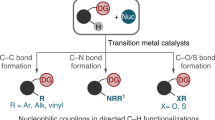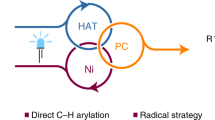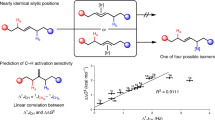Abstract
The selective transformation of ubiquitous but inert C–H bonds to other functional groups has far-reaching practical implications, ranging from more efficient strategies for fine chemical synthesis to the replacement of current petrochemical feedstocks by less expensive and more readily available alkanes. The past twenty years have seen many examples of C–H bond activation at transition-metal centres, often under remarkably mild conditions and with high selectivity. Although profitable practical applications have not yet been developed, our understanding of how these organometallic reactions occur, and what their inherent advantages and limitations for practical alkane conversion are, has progressed considerably. In fact, the recent development of promising catalytic systems highlights the potential of organometallic chemistry for useful C–H bond activation strategies that will ultimately allow us to exploit Earth's alkane resources more efficiently and cleanly.
This is a preview of subscription content, access via your institution
Access options
Subscribe to this journal
Receive 51 print issues and online access
$199.00 per year
only $3.90 per issue
Buy this article
- Purchase on SpringerLink
- Instant access to full article PDF
Prices may be subject to local taxes which are calculated during checkout







Similar content being viewed by others
References
Duetz, W. A., van Beilen, J. B. & Witholt, B. Using proteins in their natural environment: potential and limitations of microbial whole-cell hydroxylations in applied biocatalysis. Curr. Opin. Biotech. 12, 419–425 (2001)
Ortiz de Montellano, P. R. (ed.) Cytochrome P450: Structure, Mechanism and Biochemistry 2nd edn (Plenum, New York, 1995)
Brazeau, B. J. & Lipscomb, J. D. in Enzyme-Catalyzed Electron and Radical Transfer (ed. Holzenburg, A.Scrutton, N. S.) 233–277 (Kluwer, New York, 2000)
Gradassi, M. J. & Green, N. W. Economics of natural gas conversion processes. Fuel Proc. Technol. 42, 65–83 (1995)
Collman, J. P., Hegedus, L. S., Norton, J. R. & Finke, R. G. Principles and Applications of Organotransition Metal Chemistry Ch. 7, 2nd edn (Univ. Science, Mill Valley, 1987)
Sheldon, R. A. & Kochi, J. K. Metal-Catalyzed Oxidations of Organic Compounds Ch. 4 (Academic, New York, 1981)
Fryzuk, M. D. & Johnson, S. A. The continuing story of dinitrogen activation. Coord. Chem. Rev. 200–202, 379–409 (2000)
Green, M. L. H. & Knowles, P. J. Formation of a tungsten phenyl hydride derivative from benzene. J. Chem. Soc. Chem. Commun. 1677 (1970)
Foley, P. & Whitesides, G. M. Thermal generation of bis(triethylphosphine)-3,3-dimethylplatinacyclobutane from dineopentylbis(triethylphosphine)platinum(II). J. Am. Chem. Soc. 101, 2732–2733 (1979)
Bennett, M. A. & Milner, D. L. Chlorotris(triphenylphosphine)iridium(I): An example of hydrogen transfer to a metal from a coordinated ligand. J. Chem. Soc. Chem. Commun. 581–582 (1967)
Shilov, A. E. & Shteinman, A. A. Activation of saturated hydrocarbons by metal complexes in solution. Coord. Chem. Rev. 24, 97–143 (1977)
Brookhart, M. & Green, M. L. H. Carbon-hydrogen-transition metal bonds. J. Organometall. Chem. 250, 395–408 (1983)
Dawoodi, Z., Green, M. L. H., Mtetwa, V. S. B. & Prout, K. Evidence for a direct bonding interaction between titanium and a beta-C-H moiety in a titanium-ethyl compound: X-ray crystal-structure of [Ti(Me2PCH2CH2PMe2)EtCl3]. J. Chem. Soc. Chem. Commun. 802–803 (1982)
Halpern, J. Activation of carbon hydrogen-bonds by metal complexes: mechanistic, kinetic and thermodynamic considerations. Inorg. Chim. Acta 100, 41–48 (1985)
Janowicz, A. H. & Bergman, R. G. C-H activation in completely saturated hydrocarbons: direct observation of M + R-H → M(R)(H). J. Am. Chem. Soc. 104, 352–354 (1982)
Hoyano, J. K. & Graham, W. A. G. Oxidative addition of the carbon hydrogen-bonds of neopentane and cyclohexane to a photochemically generated iridium(I) complex. J. Am. Chem. Soc. 104, 3723–3725 (1982)
Shilov, A. E. & Shul'pin, G. B. Activation and Catalytic Reactions of Saturated Hydrocarbons in the Presence of Metal Complexes (Kluwer Academic, Dordrecht, 2000)
Wu, J. & Bergman, R. G. Conversion of epoxides to rhodium enolates: direct evidence for a mechanism involving initial C-H activation. J. Am. Chem. Soc. 111, 7628–7630 (1989)
Russell, G. A. in Free Radicals (ed. Kochi, J. K.) 275–331 (Wiley, New York, 1973)
Jordan, R. F. & Taylor, D. F. Zirconium-catalyzed coupling of propene and alpha-picoline. J. Am. Chem. Soc. 111, 778–779 (1989)
Jia, C. et al. Efficient activation of aromatic C–H bonds for addition to C–C multiple bonds. Science 287, 1992–1995 (2000)
Matsumoto, T., Taube, D., Periana, R. A., Taube, H. & Yoshida, H. Anti-Markovnikov olefin arylation catalyzed by an iridium complex. J. Am. Chem. Soc. 122, 7414–7415 (2000)
Watson, P. L. Methane exchange reactions of lanthanide and early transition metal methyl complexes. J. Am. Chem. Soc. 105, 6491–6493 (1983)
Thompson, M. E. et al. “Sigma bond metathesis” for C-H bonds of hydrocarbons and Sc-R (R = H, alkyl, aryl) bonds of permethylscandocene derivatives. Evidence for the noninvolvement of the pi system in electrophilic activation of aromatic and vinylic C-H bonds. J. Am. Chem. Soc. 109, 203–219 (1987)
Rothwell, I. P. Cyclometalation chemistry of aryl oxide ligation. Acc. Chem. Res. 21, 153–159 (1988)
Vidal, V., Théolier, A., Thivolle-Cazat, J., Basset, J. M. & Corker, J. Synthesis, characterization, and reactivity, in the C-H bond activation of cycloalkanes, of a silica-supported tantalum(III) monohydride complex: (≡SiO)2TaIII-H. J. Am. Chem. Soc. 118, 4595–4602 (1996)
Niccolai, G. P. & Basset, J. M. Primary selectivity in the activation of the carbon-hydrogen bonds of propane by silica supported zirconium hydride. Appl. Catal. A 146, 145–156 (1996)
Sherry, A. E. & Wayland, B. B. Metalloradical activation of methane. J. Am. Chem. Soc. 112, 1259–1261 (1990)
Wayland, B. B., Ba, S. & Sherry, A. E. Activation of methane and toluene by rhodium(II) porphyrin complexes. J. Am. Chem. Soc. 113, 5305–5311 (1991)
Cummins, C. C., Baxter, S. M. & Wolczanski, P. T. Methane and benzene activation via transient (tBu3SiNH)2Zr = NSitBu3 . J. Am. Chem. Soc. 110, 8731–8733 (1988)
Walsh, P. J., Hollander, F. J. & Bergman, R. G. Generation, alkyne cycloaddition, arene C-H activation, N-H activation, and dative ligand trapping reactions of the first monomeric imidozirconocene (Cp2Zr = NR) complexes. J. Am. Chem. Soc. 110, 8729–8731 (1988)
Bennett, J. L. & Wolczanski, P. T. Selectivities in hydrocarbon activation: kinetic and thermodynamic investigations of reversible 1,2-RH-elimination from (silox)2(tBu3SiNH)TiR (silox = tBu3SiO). J. Am. Chem. Soc. 119, 10696–10719 (1997)
Schafer, D. F. & Wolczanski, P. T. d0 alkane complexes (tBu3SiN = )3W(RH) precede C-H activation and formation of (tBu3SiN = )2(tBu3SiNH)WR/R′. J. Am. Chem. Soc. 120, 4881–4882 (1998)
Tran, E. & Legzdins, P. Thermal alkane C–H bond activation by a tungsten alkylidene complex: the reversal of α-hydrogen elimination. J. Am. Chem. Soc. 119, 5071–5072 (1997)
Stahl, S. S., Labinger, J. A. & Bercaw, J. E. Homogeneous oxidation of alkanes by electrophilic late transition metals. Angew. Chem. Int. Edn Engl. 37, 2180–2192 (1998)
Hall, C. & Perutz, R. Transition metal alkane complexes. Chem. Rev. 96, 3125–3146 (1996)
Geftakis, S. & Ball, G. E. Direct observation of a transition metal alkane complex, CpRe(CO)2(cyclopentane), using NMR spectroscopy. J. Am. Chem. Soc. 120, 9953–9954 (1998)
Weiller, B. H., Wasserman, E. P., Bergman, R. G., Moore, C. B. & Pimentel, G. C. Time-resolved IR spectroscopy in liquid rare gases: direct rate measurement of an intermolecular alkane C-H oxidative addition reaction. J. Am. Chem. Soc. 111, 8288–8290 (1989)
Bengali, A. A., Schultz, R. H., Moore, C. B. & Bergman, R. G. Activation of the C-H bonds in neopentane and neopentane-d12 by (η5-(C5(CH3)5)Rh(CO)2: spectroscopic and temporal resolution of rhodium–krypton and rhodium-alkane complex intermediates. J. Am. Chem. Soc. 116, 9585–9589 (1994)
Gross, C. L. & Girolami, G. S. Metal-alkane complexes. Rapid exchange of hydrogen atoms between hydride and methyl ligands in [(C5Me5)Os(dmpm)(CH3)H]+. J. Am. Chem. Soc. 120, 6605–6606 (1998)
Heinekey, D. M. & Oldham, W. Coordination chemistry of dihydrogen. Chem. Rev. 93, 913–926 (1993)
Bromberg, S. E. et al. The mechanism of a C-H bond activation reaction in room-temperature alkane solution. Science 278, 260–263 (1997)
Thompson, M. E. et al. σ-Bond metathesis for carbon-hydrogen bonds of hydrocarbons and Sc-R (R = H, alkyl, aryl) bonds of permethylscandocene derivatives. Evidence for noninvolvement of the π system in electrophilic activation of aromatic and vinylic C-H bonds. J. Am. Chem. Soc. 109, 203–219 (1987)
Jones, W. D. & Feher, F. J. The mechanism and thermodynamics of alkane and arene carbon-hydrogen bond activation in (C5Me5)Rb(PMe3)(R)H. J. Am. Chem. Soc. 106, 1650–1663 (1984)
Janowicz, A. H. & Bergman, R. G. Activation of C–H bonds in saturated hydrocarbons on photolysis of (η5-C5Me5)(PMe3)IrH2: relative rates of reaction of the intermediate with different types of C-H bonds and functionalization of the metal-bound alkyl-groups. J. Am. Chem. Soc. 105, 3929–3939 (1983)
McNamara, B. K., Yeston, J. S., Bergman, R. G. & Moore, C. B. The effect of alkane structure on rates of photoinduced C-H bond activation by Cp*Rh(CO)2 in liquid rare gas media: An infrared flash kinetics study. J. Am. Chem. Soc. 121, 6437–6443 (1999)
Shilov, A. E. & Shulpin, G. B. Activation and catalytic reactions of alkanes in solutions of metal complexes. Russ. Chem. Rev. 56, 442–464 (1987)
Luinstra, G. A., Wang, L., Stahl, S. S., Labinger, J. A. & Bercaw, J. E. C-H activation by aqueous platinum complexes: a mechanistic study. J. Organometall. Chem. 504, 75–91 (1995)
Shilov, A. E Activation of Saturated Hydrocarbons by Transition Metal Complexes (Reidel, Boston, 1984)
Labinger, J. A., Herring, A. M., Lyon, D. K., Luinstra, G. A., Bercaw, J. E., Horváth, I. & Eller, K. Oxidation of hydrocarbons by aqueous platinum salts: mechanism and selectivity. Organometallics 12, 895–905 (1993)
Sen, A., Benvenuto, M. A., Lin, M., Hutson, A. C. & Basickes, N. Activation of methane and ethane and their selective oxidation to the alcohols in protic media. J. Am. Chem. Soc. 116, 998–1003 (1994)
Freund, M. S., Labinger, J. A., Lewis, N. S. & Bercaw, J. E. Electrocatalytic functionalization of alkanes using aqueous platinum salts. J. Mol. Catal. 87, L11–L16 (1994)
Geletti, Y. V. & Shilov, A. E. Catalytic oxidation of alkanes by molecular oxidation. Oxidation of methane in the presence of platinum salts and heteropoly acids. Kinetics Catal. Engl. Trans. 24, 413–416 (1983)
Lin, M., Shen, C., Garcia-Zayas, E. A. & Sen, A. Catalytic Shilov chemistry: Platinum chloride-catalyzed oxidation of terminal methyl groups by dioxygen. J. Am. Chem. Soc. 123, 1000–1001 (2001)
Holtcamp, M. W., Henling, L. M., Day, M. W., Labinger, J. A. & Bercaw, J. E. Intramolecular and intermolecular C-H activation at a cationic platinum(II) center. Inorg. Chim. Acta 270, 467–478 (1998)
Johansson, L., Tilset, M., Labinger, J. A. & Bercaw, J. E. Mechanistic investigation of benzene C-H activation at a cationic platinum(II) center. Direct observation of a platinum(II) benzene adduct. J. Am. Chem. Soc. 122, 10846–10855 (1997)
Rostovtsev, V. V., Labinger, J. A., Bercaw, J. E., Lasseter, T. L. & Goldberg, K. I. Oxidation of dimethylplatinum(II) complexes with dioxygen. Organometallics 17, 4530–4531 (1998)
Periana, R. A. et al. Platinum catalysts for the high-yield oxidation of methane to a methanol derivative. Science 280, 560–564 (1998)
Waltz, K. M. & Hartwig, J. F. Selective functionalization of alkanes by transition-metal boryl complexes. Science 277, 211–231 (1997)
Chen, H. Y. & Hartwig, J. F. Catalytic, regiospecific end-functionalization of alkanes: rhenium-catalyzed borylation under photochemical conditions. Angew. Chem. Int. Edn Engl. 38, 3391–3393 (1999)
Chen, H., Schlecht, S., Semple, T. C. & Hartwig, J. F. Thermal, catalytic, regiospecific functionalization of alkanes. Science 287, 1995–1997 (2000)
Iverson, C. N. & Smith, M. R. Stoichiometric and catalytic B–C bond formation from unactivated hydrocarbons and boranes. J. Am. Chem. Soc. 121, 7096–7097 (1999)
Crabtree, R. H., Mihelcic, J. M. & Quirk, J. M. Iridium complexes in alkane dehydrogenation. J. Am. Chem. Soc. 101, 7738–7739 (1979)
Jensen, C. M. Iridium PCP pincer complexes: highly active and robust catalysts for novel homogeneous aliphatic dehydrogenations. Chem. Commun. 2443–2449 (1999)
Liu, F. C., Pak, E. B., Singh, B., Jensen, C. M. & Goldman, A. S. Dehydrogenation of n-alkanes catalyzed by iridium “pincer” complexes: regioselective formation of alpha-olefins. J. Am. Chem. Soc. 121, 4086–4087 (1999)
Liu, F. C. & Goldman, A. S. Efficient thermochemical alkane dehydrogenation and isomerization catalyzed by an iridium pincer complex. Chem. Commun. 655–656 (1999)
Author information
Authors and Affiliations
Corresponding author
Rights and permissions
About this article
Cite this article
Labinger, J., Bercaw, J. Understanding and exploiting C–H bond activation. Nature 417, 507–514 (2002). https://doi.org/10.1038/417507a
Issue Date:
DOI: https://doi.org/10.1038/417507a



